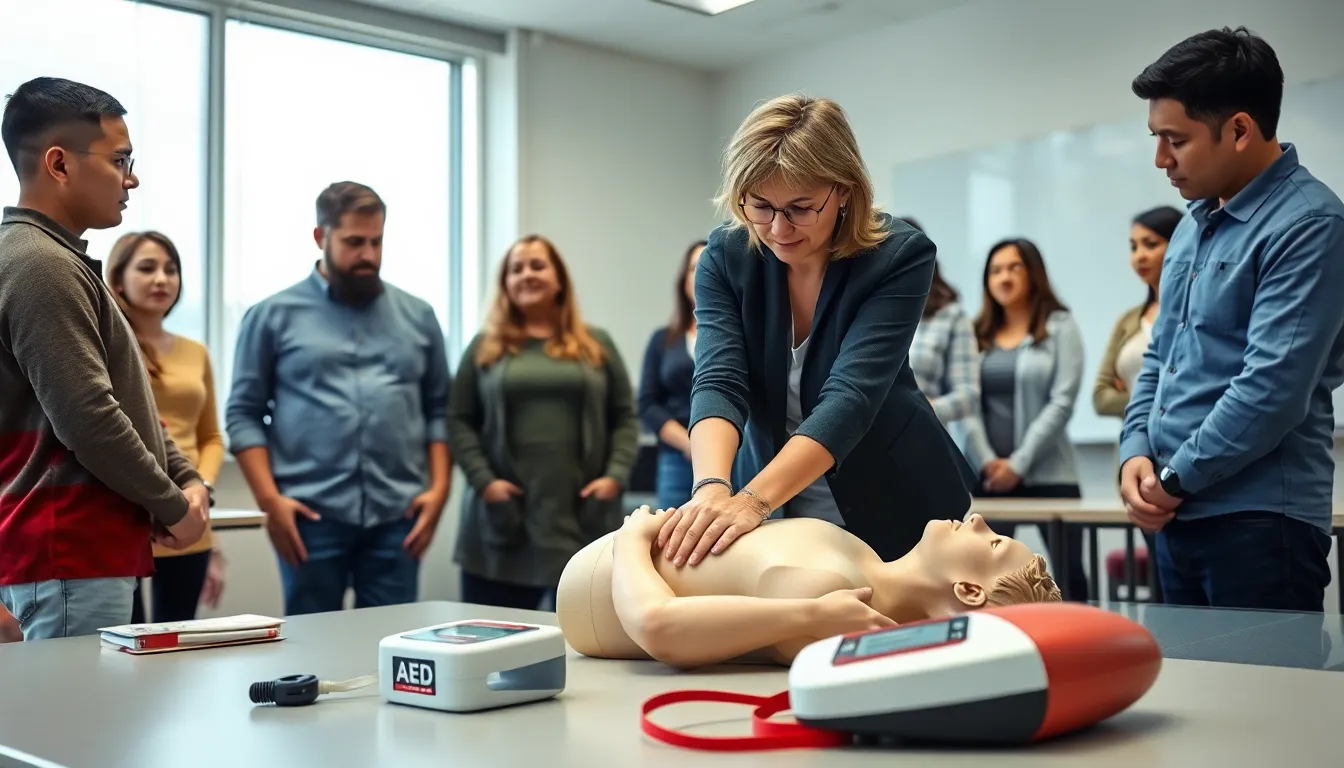In today’s fast-paced world, knowing how to respond to emergencies can make all the difference. CPR and Basic Life Support (BLS) classes equip individuals with the vital skills needed to save lives during critical situations. Whether it’s a loved one or a stranger in distress, being trained in these techniques empowers people to act confidently when every second counts.
Finding CPR and BLS classes nearby is easier than ever, with numerous options available to suit various schedules and learning preferences. Local community centers, hospitals, and specialized training organizations often offer courses led by certified instructors. By investing a few hours in training, anyone can gain the knowledge and skills necessary to respond effectively in emergencies, potentially saving lives and making a positive impact in their community.
Table of Contents
ToggleOverview of CPR BLS Classes
CPR and Basic Life Support (BLS) classes equip individuals with critical skills for emergency situations. These classes teach techniques for performing cardiopulmonary resuscitation (CPR) and using automated external defibrillators (AEDs). Participants learn how to recognize signs of cardiac arrest and respond effectively.
Classes typically cover the following topics:
- CPR Techniques: Instruction on chest compressions and rescue breaths, ensuring proper hand placement and depth.
- AED Use: Training on how to operate AEDs, including pad placement and following voice prompts.
- Choking Relief: Methods to assist someone experiencing choking, utilizing the Heimlich maneuver or back blows.
- BLS Protocols: Understanding the steps in a systematic approach to managing cardiac arrest and unresponsive victims.
These courses vary in length, often ranging from a few hours to a full day, accommodating different schedules and learning preferences. Certification is commonly available upon completion, which can enhance employability in healthcare and related fields.
Class availability typically includes numerous local options, such as:
- Community Centers: Offering accessible and affordable training.
- Hospitals: Providing official certifications with professional instructors.
- Training Organizations: Presenting specialized courses, including tailored programs for specific professions.
By attending CPR BLS classes, individuals not only gain essential skills but also contribute to safer communities.
Importance of CPR and BLS Training

CPR and Basic Life Support training equips individuals with critical skills vital for emergency response. Understanding these techniques can lead to life-saving actions during cardiac emergencies.
Life-Saving Benefits
Life-saving skills offered by CPR and BLS training can drastically improve outcomes in emergencies. Each year, thousands experience sudden cardiac arrest, with survival rates significantly increasing when CPR is administered promptly. Studies show that immediate CPR can double or triple chances of survival. Furthermore, knowing how to use an AED enhances effectiveness during critical moments, as each minute without defibrillation reduces survival rates by approximately 10%.
Skills Acquired in Training
Skills acquired through CPR and BLS training are essential in providing effective emergency care. Participants learn several key techniques, including:
- CPR Techniques: Performing high-quality chest compressions and rescue breaths.
- AED Usage: Operating an automated external defibrillator correctly.
- Choking Relief: Administering the Heimlich maneuver to assist choking victims.
- Recognition: Identifying signs of cardiac emergencies, such as unresponsiveness or abnormal breathing.
Training sessions typically combine hands-on practice with theory, ensuring participants gain confidence in their ability to respond. Certification often follows completion, enhancing professional qualifications for those seeking careers in healthcare or emergency response.
Finding CPR BLS Classes Near Me
Individuals seeking CPR and BLS classes can utilize various online resources and local facilities. These avenues provide essential information on available training options, helping to ensure timely access to life-saving education.
Online Resources and Directories
Utilizing online resources accelerates the search for CPR and BLS classes. Websites like the American Heart Association and the Red Cross offer searchable directories that list certified training providers based on location. These platforms often include course outlines, schedules, and registration details. Online platforms also frequently feature user reviews and ratings, assisting in selecting reputable programs. Additionally, local community boards and health-focused websites can offer up-to-date information about classes in the area.
Local Community Centers and Hospitals
Local community centers and hospitals serve as accessible venues for CPR and BLS classes. Many community centers offer training at affordable rates, often tailored to various skill levels. Hospitals frequently host courses taught by healthcare professionals, providing participants with practical insights from those actively engaged in emergency response. Checking local bulletin boards and hospital websites can reveal upcoming class schedules or special events related to CPR and BLS training. Inquiring directly with these facilities may uncover additional sessions, certifications, or even mobile training units that bring the instruction to underserved areas.
What to Expect in a CPR BLS Class
CPR and BLS classes provide structured learning experiences designed to equip participants with critical life-saving skills. Those who enroll can anticipate a blend of theoretical knowledge and hands-on practice.
Course Structure and Duration
Courses usually consist of several components, including lectures, demonstrations, and practical exercises. Participants will typically engage in sessions covering foundational topics, including:
- CPR techniques: Training focuses on high-quality chest compressions and rescue breaths.
- AED usage: Instruction on automated external defibrillator operation is crucial for cardiac emergencies.
- Choking relief methods: Participants learn the Heimlich maneuver and techniques for infants and adults.
Classes generally last between 4 and 8 hours, depending on the certification level and provider. Some programs may offer the possibility of compressed courses over weekends or in shorter segments for maximum flexibility.
Certification Process
The certification process solidifies competency in lifesaving techniques. Upon successful completion of the course, individuals typically receive a certification card valid for 2 years. This card indicates proficiency in:
- CPR and BLS skills: Participants demonstrate their ability to perform CPR and use AEDs effectively.
- Choking relief execution: Completion includes a demonstration of proper choking relief techniques.
Many reputable organizations, such as the American Heart Association and Red Cross, administer the certification. Some employers, especially in the healthcare field, may require specific certifications, making this training essential for career advancement. Participants should ensure they understand any prerequisites before enrolling and inquire about any additional certification exams that may be necessary.
Investing time in CPR and BLS classes is a proactive step towards enhancing personal safety and community well-being. With accessible training options available nearby, individuals can equip themselves with life-saving skills that make a real difference in emergencies.
These classes not only empower participants with the knowledge to respond effectively but also foster a culture of preparedness within communities. By choosing to learn CPR and BLS techniques, individuals contribute to a safer environment for everyone. Whether for personal growth or career advancement, the benefits of this training extend far beyond the classroom.



